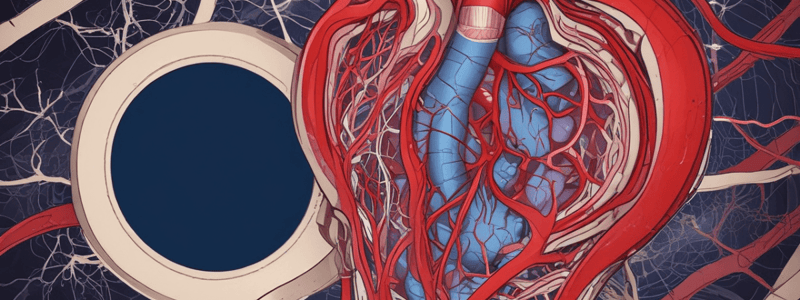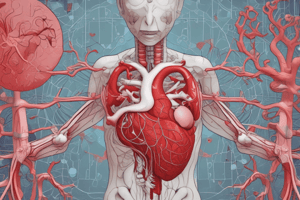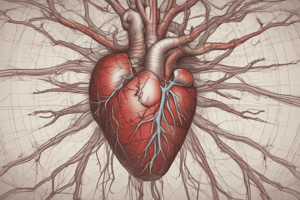Podcast
Questions and Answers
What is the primary cause of thrombus formation in deep vein thrombosis?
What is the primary cause of thrombus formation in deep vein thrombosis?
- Inflammation in the affected site
- Sluggish blood flow in the affected vessels (correct)
- Turbo flow in the affected vessels
- Increased blood clotting cascade
Which of the following is NOT a risk factor for hypertension?
Which of the following is NOT a risk factor for hypertension?
- Abdominal obesity
- Glucose intolerance
- High potassium intake (correct)
- Sedentary lifestyle
What is the result of chronic hypertension on the cardiovascular system?
What is the result of chronic hypertension on the cardiovascular system?
- Vasoconstriction and increased cardiac output
- Vascular remodelling and cardiac hypertrophy (correct)
- Increased peripheral resistance and decreased renal vascular resistance
- Vasodilation and decreased cardiac output
What is the primary cause of isolated systolic hypertension in the elderly?
What is the primary cause of isolated systolic hypertension in the elderly?
What is the result of a thrombus becoming loose and travelling through the circulation?
What is the result of a thrombus becoming loose and travelling through the circulation?
What is the definition of hypertension?
What is the definition of hypertension?
What is the result of malignant hypertension?
What is the result of malignant hypertension?
What is the clinical manifestation of hypertension?
What is the clinical manifestation of hypertension?
What is the result of endothelial damage in atherosclerosis?
What is the result of endothelial damage in atherosclerosis?
Which of the following is a consequence of vasoconstriction in atherosclerosis?
Which of the following is a consequence of vasoconstriction in atherosclerosis?
What is the role of smooth muscle cells in atherosclerosis?
What is the role of smooth muscle cells in atherosclerosis?
Which of the following is a risk factor for atherosclerosis that can also contribute to vasoconstriction?
Which of the following is a risk factor for atherosclerosis that can also contribute to vasoconstriction?
What is the result of an unstable plaque rupturing in atherosclerosis?
What is the result of an unstable plaque rupturing in atherosclerosis?
What is the effect of aspirin on atherosclerosis?
What is the effect of aspirin on atherosclerosis?
What is the main function of the sympathetic nervous system in the tunica media layer of blood vessels?
What is the main function of the sympathetic nervous system in the tunica media layer of blood vessels?
What is the effect of endothelin on blood vessels?
What is the effect of endothelin on blood vessels?
Which of the following chemical mediators is involved in vasodilation?
Which of the following chemical mediators is involved in vasodilation?
What is the result of a damaged endothelium in terms of coagulation and anticoagulation?
What is the result of a damaged endothelium in terms of coagulation and anticoagulation?
What is the function of the smooth muscle layer in the tunica media?
What is the function of the smooth muscle layer in the tunica media?
Which of the following is NOT a function of the endothelium?
Which of the following is NOT a function of the endothelium?
Flashcards are hidden until you start studying
Study Notes
Blood Vessels
- Blood vessels are composed of three distinct layers: tunica externa, tunica media, and tunica interna.
- Tunica externa is the outer layer, composed of collagen fibers, and is supplied with sympathetic nerve fibers and lymphatic vessels.
- Tunica media is the middle layer, containing smooth muscle and elastic tissue, and is innervated by the sympathetic nervous system.
- Tunica interna is the inner layer, lined with endothelium, which makes the inner surface smooth and minimizes friction as blood flows through the vessel.
Endothelium
- Endothelium is involved in coagulation, antithrombosis, and fibrinolysis, as well as immune function, vasodilation or constriction, tissue growth, and wound healing.
- Endothelium produces chemical mediators that cause vasodilation or vasoconstriction.
- A healthy intact endothelium tends toward anticoagulation, but if damaged, the balance switches in favor of clot formation.
Arteries and Veins
- Arteries have thick walls and narrow lumen, and respond to hormonal and neural signals.
- There are three groups of arteries: elastic arteries, muscular arteries, and arterioles.
- Veins have thinner walls, contain fewer elastic and collagen fibers, and less smooth muscle, and have a larger lumen.
Atherosclerosis
- Atherosclerosis is a form of arteriosclerosis with soft deposits of intra-arterial fat and other variations depending on the severity of the condition.
- Risk factors for atherosclerosis include hypertension, obesity, smoking, alcohol, diabetes, and male gender.
- Atherosclerosis causes coronary heart disease and cerebrovascular disease.
Pathophysiology of Atherosclerosis
- Endothelial injury leads to inflammation, smooth muscle cell migration, and collagen deposition, forming a fibrous plaque.
- The fibrous plaque may calcify, protrude into the lumen, and obstruct blood flow, becoming an "unstable" plaque prone to rupture.
- Rupture of the plaque leads to platelet adhesion, tissue clotting factors, and thrombus formation, causing complete blockage of the vessel.
Clinical Manifestations of Atherosclerosis
- Partial obstruction of the vessel may cause transient ischemic events, stress, or exercise.
- Further obstruction may lead to infarction, with manifestations depending on the vessels involved, such as heart attack or stroke.
- Peripheral artery obstruction may cause pain and disability, especially in the lower limbs.
Management of Atherosclerosis
- Modification of lifestyle factors, control of diabetes and hypertension, improvement of serum lipids, and aspirin therapy may be indicated.
- Dyslipidemia, a metabolic disorder characterized by increased concentrations of plasma cholesterol and triglycerides, is a key factor in atherosclerosis.
Deep Vein Thrombosis (DVT)
- A thrombus develops in the superficial or deep veins of the legs, triggered by sluggish blood flow and the clotting cascade.
- The thrombus can become loose and travel through the circulation as an embolus, causing pulmonary embolism.
Hypertension
- Hypertension is defined as repeated measurements of over 140/90 mmHg.
- Secondary hypertension is caused by kidney disease, endocrine imbalance, and other factors.
- Malignant hypertension occurs in younger groups with renal and collagen disease.
- Isolated systolic hypertension occurs in the elderly due to increased cardiac output, peripheral resistance, and renal vascular resistance.
Risk Factors for Hypertension
- Risk factors include family history, age and gender, abdominal obesity, alcohol intake, glucose intolerance, high sodium intake, sedentary lifestyle, and low potassium, calcium, and magnesium intake.
Clinical Manifestations of Hypertension
- Hypertension is considered a silent condition, with symptoms arising due to associated damage of organs and vascular changes, such as heart disease, renal insufficiency, brain dysfunction, impaired vision, impaired mobility, and vascular occlusion and edema.
- Chronic hypertension leads to vascular remodeling, renal changes, and cardiac hypertrophy, increasing the risk of myocardial infarction, kidney disease, and stroke.
Evaluation of Hypertension
- Evaluation includes repeated high BP measurement, history and physical examination, and other diagnostic tests.
Studying That Suits You
Use AI to generate personalized quizzes and flashcards to suit your learning preferences.




